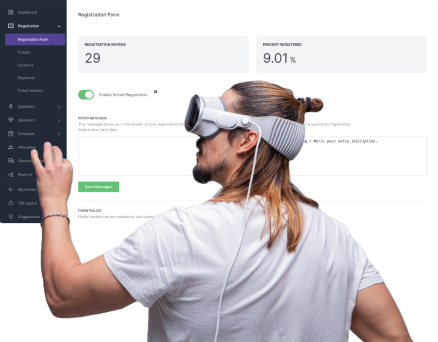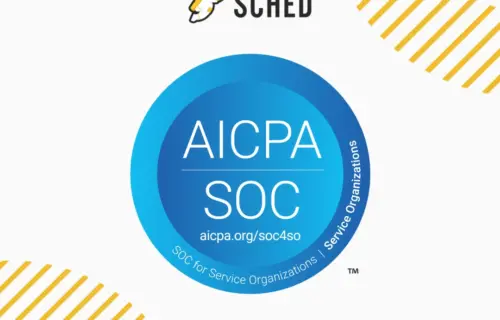The resurgence of in-person events highlights the intrinsic value of face-to-face interactions in an increasingly digital world.
From conferences and workshops to festivals, these events provide unique opportunities for networking, learning, and creating memorable experiences.
The power of meeting someone face-to-face and participating in real-time interactions cannot be substituted by virtual alternatives.
In this article, we’ll explore the benefits, logistics, and planning tips for successfully hosting and attending in-person events.
TL;DR
Table of contents
- 1 TL;DR
- 2 What Is An In-Person Event?
- 3 The Advantages Of In-Person Events
- 4 In-Person Events Examples And Types
- 5 Hosting A Successful In-Person Event: Full 5-Step Guide
- 6 Physical vs. Virtual vs. Hybrid Events: Comparison
- 7 7 Major Challenges Of In Person Events & Tips To Overcome Them
- 8 The takeaways
- 9 FAQs
- 9.1 Are in-person events better than virtual events?
- 9.2 What is required to host an in-person event?
- 9.3 How to find the best in-person event venues?
- 9.4 What is sustainability in event planning?
- 9.5 How to attract sponsors for your event?
- 9.6 How to promote an in-person event?
- 9.7 Why is the location important for in-person events?
- 9.8 What are event activities for in person events and why are they important?
- In-person events offer unique networking opportunities that are not easily replicated online.
- Engagement and interaction at live events enhance learning and experience through direct communication.
- Event logistics can be more complex, requiring careful planning and coordination.
What Is An In-Person Event?
An in-person event involves individuals gathering physically at a specific venue.
These events can include conferences, seminars, trade shows, and social gatherings.
People value these events because they offer opportunities for networking, collaboration, and community building.
In-person meetings and gatherings provide meaningful ways to connect with others, building a shared experience.
Factors such as venue selection, logistics, and health and safety play a crucial role in the success of these events.
Creating a safe and welcoming physical environment is essential.
These events typically consider aspects like accessibility, facilities, and attendee comfort.
The Advantages Of In-Person Events
1. In-Person Experience
Attendees benefit from the tangible experience of being physically present. This interaction fosters stronger personal connections and aids in community building.
2. Networking Opportunities
Face-to-face meetings often lead to more meaningful networking. In-person events facilitate deeper conversations and the exchange of ideas, providing opportunities to meet industry leaders and potential collaborators.
3. Engagement
Physical attendance enhances engagement. Participants are more likely to stay focused and interact during sessions and activities, as opposed to virtual events where distractions are more common.
4. Learning and Development
Live events provide an engaging platform for learning. Workshops, seminars, and breakout sessions allow for interactive learning experiences that can be more impactful than virtual alternatives.
5. Visibility and Presence
Being present at events increases visibility for individuals and businesses. Attendees can showcase their expertise, products, or services, establishing a stronger presence in their industry.
6. Boost to Local Economies
In-person events drive economic benefits for host cities. Local businesses experience increased foot traffic from attendees staying in hotels, dining at restaurants, and shopping locally.
7. Enhanced Sensory Experience
Physical events engage multiple senses, leading to a more immersive experience. The atmosphere, sights, sounds, and even the camaraderie of attendees contribute to a memorable event.
8. Event-Specific Benefits
Specific elements such as product demonstrations, live performances, and hands-on activities are more effective in person. Attendees can directly interact with products and see them in action, which is often impossible in virtual settings.
9. Immediate Feedback
Organizers and presenters can gauge audience reactions in real time. This feedback allows for quick adjustments and improvements, ensuring the audience remains engaged and satisfied.
In-Person Events Examples And Types
1. Conferences and Conventions
Conferences bring together professionals to discuss industry trends and share knowledge. Conventions, often larger, serve similar purposes but can include trade shows and exhibitions.
2. Workshops and Seminars
These events offer hands-on learning experiences. Workshops provide practical training, while seminars focus on theoretical knowledge sharing.
3. Trade Shows and Expos
Trade shows showcase products and services from various companies, enabling businesses to connect. Expos, similar to trade shows, often target the general public and highlight new innovations.
4. Networking Events
Designed to foster professional connections, these events include business mixers and networking luncheons. Attendees can exchange ideas and build relationships.
5. Product Launches
Companies use these events to introduce new products. The goal is to create buzz and engagement through demonstrations and interactive experiences.
6. Corporate Retreats
Corporate retreats are designed for team building and strategic planning. These events help improve communication and foster a collaborative culture within organizations.
7. Team Building Activities
These activities, like outdoor challenges and group exercises, aim to strengthen team dynamics and improve cooperation.
8. Festivals and Fairs
These large-scale events celebrate various themes and attract diverse crowds. Examples include music festivals, food fairs, and cultural celebrations.
9. Award Ceremonies
Recognizing achievements and excellence, award ceremonies bring together industry leaders and professionals to celebrate accomplishments.
10. Community Events
Events like charity runs, local fairs, and public forums engage the community and promote social cohesion.
Hosting A Successful In-Person Event: Full 5-Step Guide
Step 1: Define Clear Goals and Objectives
Outlining the purpose of the event is vital. Whether it’s a medical congress or a business seminar, clear goals guide all decisions.
Establish what success looks like—networking, education, or product launches—and tailor the event around these objectives.
Step 2: Detailed Planning and Preparation
Start planning 6-12 months in advance. Use an event brief to map out key milestones and deadlines.
This timeframe allows adequate organization of logistics, venue, speakers, and marketing strategies. Make sure to also factor in the latest health and safety protocols.
Step 3: Venue Selection and Setup
Choose a venue that aligns with the event’s scale and objective. Consider accessibility, facilities, and location.
Ensure the physical environment is welcoming and safe, with enough space for all attendees. Don’t forget to arrange necessary equipment and decor.
Step 4: Engaging Content and Interaction
Develop content that resonates with the audience. Create an engaging agenda with diverse sessions—keynotes, panels, and workshops.
Encourage interaction through Q&A segments, networking opportunities, and interactive activities. Incorporating technology such as apps can facilitate smoother event flow.
Step 5: Execution and Onsite Management
On the day of the event, ensure smooth execution with a well-coordinated team.
Assign roles for registration, technical support, and guest assistance. Keep track of the schedule and be prepared to handle any unforeseen issues promptly. Continuous communication among staff is key.
Physical vs. Virtual vs. Hybrid Events: Comparison
In-Person Events
In-person or physical events take place in a specific location where participants gather. They provide opportunities for face-to-face interactions, which can enhance networking and personal connections.
These events often require substantial logistics and planning regarding venue, catering, and travel arrangements.
Virtual Events
Virtual events occur entirely online. Participants join from their own locations, reducing travel and venue costs.
Technology platforms facilitate these events, offering tools for presentations, Q&A sessions, and networking through virtual chat rooms or other interactive features.
Hybrid Events
Hybrid events combine physical and virtual elements. They allow attendees to participate either in-person or remotely.
This type of event offers flexibility and can attract a broader audience. For instance, a conference might host a live audience while streaming sessions to virtual participants.
Comparison Chart: In-Person vs. Virtual vs. Hybrid
| Aspect | Physical | Virtual | Hybrid |
| Interaction | Direct, face-to-face | Online, through chat and video | Both direct (in-person) and online |
| Cost | Higher (venue, travel, catering) | Lower (no travel or venue costs) | Medium (combination of physical and virtual costs) |
| Flexibility | Fixed location and time | Accessible from anywhere, anytime | Flexible participation options |
| Audience Size | Limited by venue capacity | Virtually unlimited | Potentially larger due to dual formats |
| Engagement | High due to physical presence | Can vary, dependent on technology | High if both formats are effectively integrated |
7 Major Challenges Of In Person Events & Tips To Overcome Them
1. Budgeting Constraints
Allocating funds efficiently can be difficult. Balancing quality and cost is essential.
Tip: Create a detailed budget plan early, allocate for emergencies, and regularly review expenses.
2. Venue Selection
Choosing the right venue impacts attendance and satisfaction.
Tip: Consider the location, size, amenities, and accessibility to ensure it meets all requirements.
3. Health and Safety
Ensuring the safety of attendees is a top priority.
Tip: Implement strict health protocols, provide sanitizing stations, and ensure emergency services are on standby.
4. Attendee Engagement
Keeping attendees engaged throughout the event can be challenging.
Tip: Use interactive sessions, live polls, and networking opportunities to maintain interest.
5. Technology Issues
Technical difficulties can disrupt the event flow.
Tip: Test all equipment beforehand, have technical support on-site, and use reliable technology.
6. Marketing and Promotion
Attracting participants requires effective marketing strategies.
Tip: Utilize social media, email campaigns, and partnerships to reach a broader audience.
7. Logistical Challenges
Coordinating transportation, accommodation, and on-site management involves complex logistics.
Tip: Plan meticulously, hire experienced staff, and use event management software for smooth operations.
The takeaways
- In-person events offer unparalleled opportunities for face-to-face networking, fostering deeper connections and more meaningful interactions that are often difficult to achieve in virtual settings.
- Physical attendance at events enhances engagement and focus, leading to more effective learning and a richer overall experience through real-time, interactive sessions.
- Organizing in-person events requires meticulous planning, including venue selection, health and safety measures, and coordination of logistics, making thorough preparation essential for success.
- In-person events boost local economies through increased foot traffic and provide a multi-sensory, immersive experience that leaves a lasting impression on attendees.
FAQs
Are in-person events better than virtual events?
In-person events offer unique benefits compared to virtual events.
They provide opportunities for face-to-face interactions and real-time networking, which can foster stronger connections among attendees.
Additionally, these events often create more memorable experiences through physical interaction with the environment and other participants.
Virtual events, on the other hand, are more accessible to a global audience and often more cost-effective.
The choice between in-person and virtual events depends on factors like budget, target audience, and event goals.
What is required to host an in-person event?
Hosting an in-person event requires careful planning and consideration of several key elements.
First, a suitable venue that aligns with the event’s size and purpose is essential.
Organizers must also ensure there are adequate facilities, such as restrooms, seating, and accessibility options.
Logistical aspects like security, transportation, parking, and accommodation for attendees must be arranged.
Additionally, event permits, insurance, and compliance with health and safety regulations are crucial.
Engaging speakers or entertainers, catering, and providing an overall positive attendee experience are also vital components.
How to find the best in-person event venues?
Selecting the ideal venue for an in-person event involves several factors:
- Location is crucial; it should be easily accessible to the majority of attendees.
- Evaluate the venue’s capacity to ensure it can comfortably accommodate the expected number of participants.
- Consideration of the venue’s amenities, such as technical equipment, catering services, and parking facilities, is important.
- Cost is another significant factor; ensure the venue fits within the event’s budget.
- It’s also beneficial to read reviews and possibly visit the venue in person before making a final decision.
What is sustainability in event planning?
Sustainability in event planning refers to organizing events in environmentally conscious ways that minimize negative impacts on the environment.
This involves reducing waste, conserving resources, and promoting eco-friendly practices.
Key practices include choosing venues with green certifications, using digital materials instead of printed ones, and incorporating recycling programs.
Additionally, opting for sustainable catering options, reducing energy consumption, and encouraging public transport or carpooling can enhance an event’s sustainability.
Engaging vendors who share similar environmental values can further these efforts.
How to attract sponsors for your event?
Attracting sponsors requires a clear value proposition.
Identify potential sponsors whose brand aligns with the event’s theme and audience.
Create a compelling sponsorship package that outlines various levels of sponsorship and the benefits for each level, such as brand visibility, networking opportunities, and audience engagement.
Personalized outreach is key.
Approach potential sponsors with tailored pitches that highlight how the partnership can meet their marketing and business objectives.
Offering exclusive sponsorship opportunities, such as naming rights or keynote sessions, can also be appealing.
Maintaining open communication and demonstrating past event successes can build confidence among prospective sponsors.
How to promote an in-person event?
Effective promotion of an in-person event leverages multiple channels to reach the target audience:
- Utilize social media platforms to create buzz and engage with potential attendees.
- Email marketing campaigns can provide detailed information and updates about the event.
- Collaboration with influencers or industry leaders can amplify reach.
- Creating engaging content, like teaser videos or blog posts, also attracts interest.
- Paid advertising, such as search engine ads or social media boosts, can target specific demographics.
Why is the location important for in-person events?
The location of an in-person event significantly impacts its success.
A convenient and accessible location ensures higher attendance.
Factors like proximity to public transportation, parking facilities, and nearby accommodations are crucial.
The location should also complement the event’s theme and purpose.
A corporate event might prefer a downtown hotel, while a community fair may benefit from an outdoor park.
Additionally, local attractions and amenities can enhance the attendee experience by providing opportunities for extended stays or auxiliary activities.
What are event activities for in person events and why are they important?
Event activities are essential for engaging attendees and enhancing their overall experience.
Activities such as workshops, networking sessions, and interactive exhibits facilitate learning and connections.
Engaging entertainment, such as live music or performances, can keep the energy high and create memorable moments.
Incorporating diverse activities that cater to different interests ensures that all attendees find value in the event.
Interactive technology, like photo booths or virtual reality stations, can add a modern touch.
Thoughtfully planned activities not only entertain but also foster networking, learning, and social interaction, which are key benefits of in-person events.









